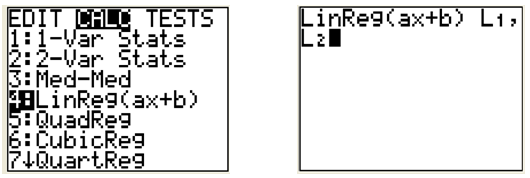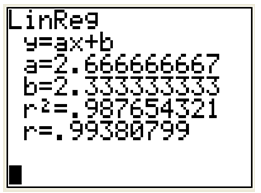Pearson's Correlation Coefficient
| Sitio: | Clare |
| Curse: | Michigan Algebra I Sept. 2012 |
| Libro: | Pearson's Correlation Coefficient |
| Impreso por: | Cuenta visitante |
| Fecha: | sábado, 13 de diciembre de 2025, 14:18 |
Descripción
Pearson's Correlation Coefficient
Definition
The coefficient also tells you if the relationship is positive or negative by whether the value of r is positive or negative. Positive correlation indicates that as the values of x increase, the values of y also increase. A negative correlation indicates that as one variable increases, the other decreases.
The formula for r-value is as follows:

Mostly calculators and computers are used to find the coefficient. It is the expectation of this course that you will understand how to use and interpret the coefficient, not calculate it using the formula.
Graphs of the Coefficient



Values of the Coefficient
If a correlation coefficient is found that is larger than +1 or less than - 1, there must have been a calculation error. Keep this in mind when calculating a correlation coefficient.
Online Practice
Pearson's Correlations Online Practice
Interactive Activity
r-value interactive
Using a Calculator
Step 1. Press 2nd [CATALOG] [D]. Scroll down to Diagnostic On. Press ENTER ENTER. (Note: You need to do this step only once. After you turn the diagnostics on, the setting remains on.)


Step 3. The calculator displays the value of r, which in this case is .99380799. It also displays other information about the least squares line, which you'll learn about later.

Guided Practice
Hotmath Guided Practice
Sources
EvoTutor, "Correlation Coefficient." http://www.evotutor.org/ Statistics/St2A.html (accessed 08/27/2010).
HotMath.com, "Practice Problems." http://hotmath.com/help/ gt/genericalg2/section_2_6.html (accessed 08/27/2010).
MathBits.com, "Correlation Coefficient." http://mathbits.com/ MathBits/TISection/Statistics2/correlation.htm (accessed 08/22/2010).
Stat Istics , "Guessing Correlations ." http://istics.net/stat/Correlations/ (accessed 9/15/2010).
University of the West of England, "Pearson Correlation Coefficients." http://hsc.uwe.ac.uk/dataanalysis/quantInfAssPear.asp (accessed 08/22/2010).
Winks, "Pearson Correlation Coefficient." http://www.texasoft.com/ winkpear.html (accessed 08/22/2010).